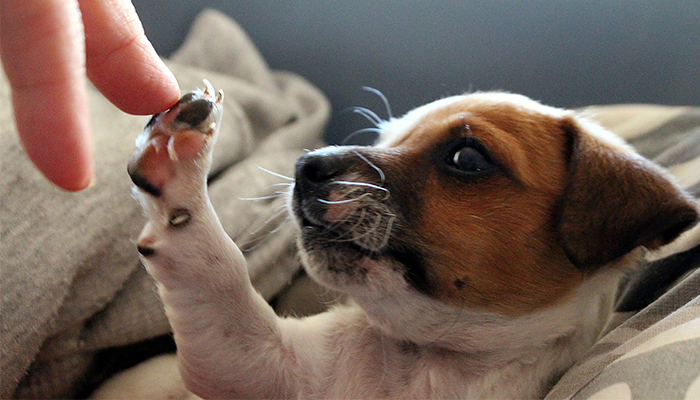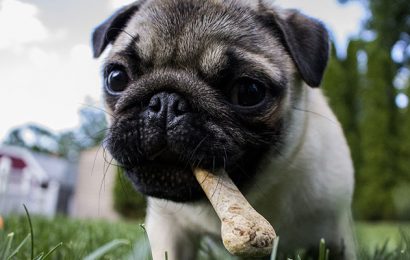Like bringing home an infant for the first time, bringing home a new puppy requires a little preparation. You want to make the transaction to the dog’s new home a smooth one. You want to bring the puppy home to a calm, supportive and properly prepared environment.
Bringing a puppy home, supplies you need:
Two bowls, food and water. Stainless steel is ideal, heavy, unbreakable, and unlikely to be knocked over. Ceramic can chip, and puppies may chew a plastic bowl.
Dog crate benefits: the enclosure acts as a cozy den; makes puppies feel safe when family is away; encourages bladder control since dog’s dislike to urinate where they sleep. Plastic crates are standard for travel but can be used daily. Wire dog crates provide better ventilation and viewing. Wicker crates are more attractive but can be chewed. When bringing a puppy home, alternatives to crates are playpens, or gated enclosures. Gates prevent puppies from climbing or falling down stairs, until freer roam is allowed. Note that confinement in damp, dark quarters, as basements and garages, leads to housebreaking problems.
Until the puppy you bring home is past the chewing stage and housebroken, avoid bedding. Instead, an old quilt or flat mat identifies a place in the room for the puppy. Take the quilt/mat on trips as a security blanket. Puppy supplies should include chew toys and play toys. Never use shoes or garments, unless you want good shoes and garments chewed and played with in the future. When you bring home a puppy, use a 4-6 foot drag leash of lightweight nylon for quick corrections in the house. In the yard, a 30-plus foot long line allows freedom to play but gives you control.
When bringing home a puppy, consider an identification microchip, injected into the puppy’s neck or shoulder by the breeder or veterinarian. Have an ID tag with your address and telephone number attached to an adjustable buckle collar (preferably rounded) holding the puppy’s other tags. After about 12 weeks, the puppy is conditioned to wear the collar. Don’t put the dog’s name on the ID since the name could endear it to wrongdoers. Puppy supplies also include a training collar.
The basic types: the head collar, muzzle-like in appearance, is probably the most humane way to walk your dog since it eliminates pressure around the neck. The chain collar, or choke collar, should never be left on the dog when not in use. Master the “zipper tug” of the chain collar since the puppy learns by the sound and not the restraint. A nylon training collar can be used on more cooperative dogs instead of the chain collar.

When you bring home a puppy and it has grown a bit, you need a teaching lead for: leading the puppy around the house on a leash, anchoring (when you are sitting), and stationing (settling the puppy into selected areas). The teaching lead has 4 benefits: substitutes for the crate when family is home, encourages good manners, helps teach everyday commands, helps resolve housebreaking and other annoying habits.
Before the trip home:
Before bringing a puppy home, the breeder should tell you the feeding schedule and how much food it gets. Take a week’s supply of that food to avoid upsetting the puppy’s system by sudden changes. Inquire when the puppy may need to defecate and about how often.
For the trip home, have a large towel folded to make a padded surface, and settle the dog quickly on someone’s lap, but never on the driver’s lap. Avoid the front seats, where the airbags are located. In the best case, the trip home is during naptime. If the puppy whines, settle it by placing a reassuring hand on it and remain still; no baby talk or petting, and the puppy will likely fall asleep. Have an extra towel if the puppy becomes car sick. Don’t fuss if it happens — replace the towel with a clean one and maintain a calm environment.
The first hours together:
The first hours at home with your new puppy will leave an indelible impression — it is especially important to make them pleasant. If you become anxious or impatient, the puppy will sense this and you risk anxiety-driven behavior problems.
Take the new dog directly to the area for relieving itself. Stand quietly, don’t distract the dog, let it sniff. Stay until the dog urinates or defecates. It will likely do sol shortly after eating. If the puppy cooperates, immediately heap praise on the dog, and point to the deposit. Get the puppy to look or sniff at its work so it understands what you are pleased about. Make it a celebration! The faster the puppy understands what you are pleased about, the more it will look to please you. Communication is key after bringing your puppy home.




